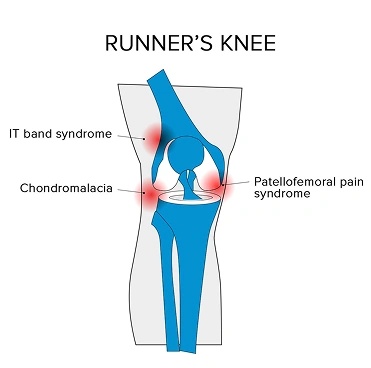If you are passionate about running, you know the sense of freedom that comes with hitting the track or trail.
Unfortunately, that joy can quickly fade when knee pain enters the picture. One of the most common issues runners face is patellofemoral pain syndrome, more commonly known as runner’s knee.
Understanding why it happens and what you can do to prevent it is key to keeping your stride strong and pain-free.
What is Runner’s Knee?
Runner’s knee refers to pain around or behind the kneecap.
It is not a single condition but rather a general term for a group of problems that cause knee discomfort, especially during running, climbing stairs, squatting, or sitting for long periods.
Why Runner’s Knee Happens
Several factors contribute to runner’s knee, including:
1. Overuse
Repetitive stress from long-distance running or intense training can irritate the tissues around the knee.
2. Weak or Imbalanced Muscles
Weak quadriceps or hip muscles can affect how the kneecap tracks, causing misalignment and pain.
3. Poor Running Form
Overstriding, improper footwear, or running on hard or uneven surfaces can increase knee stress.
4. Previous Injuries
Past injuries to the knee, hip, or ankle can alter movement patterns and put extra strain on the knee joint.

Symptoms to Watch For
- Pain around or behind the kneecap, especially while running or bending the knee
- Grinding or popping sensations
- Swelling around the knee
- Pain after sitting for a long time
How to Prevent Runner’s Knee
1. Strengthen Your Muscles
Focus on strengthening the quadriceps, hamstrings, glutes, and hip muscles. Strong muscles help support proper knee alignment.
2. Improve Flexibility
Stretch your hamstrings, calves, and hip flexors regularly to prevent tightness that can pull the knee out of balance.
3. Choose Proper Footwear
Invest in shoes that provide good cushioning and support for your foot type. Worn-out shoes can increase stress on the knees.
4. Pay Attention to Running Form
Maintain a steady stride, avoid overstriding, and try to land softly with each step.
5. Cross-Train
Mix running with low-impact activities like swimming or cycling to reduce repetitive strain.
6. Do Not Skip Warm-Ups and Cool-Downs
Gentle stretches and mobility exercises before and after running prepare your joints and muscles for activity.
Recovery if Runner’s Knee Strikes
If you are already experiencing pain, rest and ice can help in the short term.
Physiotherapy exercises, taping techniques, or braces may also support recovery. In persistent cases, consult a medical professional for personalized treatment.
Runner’s knee does not mean the end of your running journey. By listening to your body, strengthening supporting muscles, and adopting smart running habits, you can reduce your risk and enjoy the miles ahead with confidence.
Latest News & Blogs

Menopause and Bone Loss: How to Stay Strong Through Hormonal Changes
Menopause and Bone Loss Prevention Tips for Women

Sitting Too Long? The Hidden Risks of a Sedentary Lifestyle
Health Risks of a Sedentary Lifestyle and How to Avoid Them

Rotator Cuff Injuries: Prevention and Recovery for Active Adults
Rotator Cuff Injury Prevention and Recovery Tips



